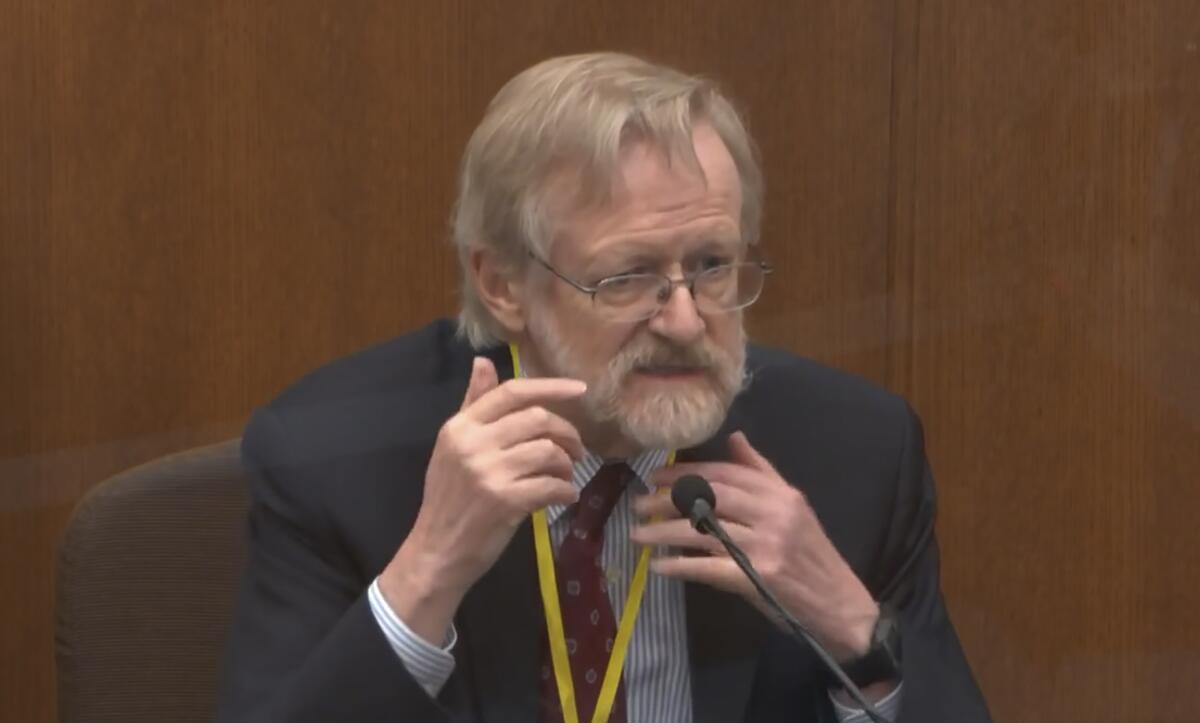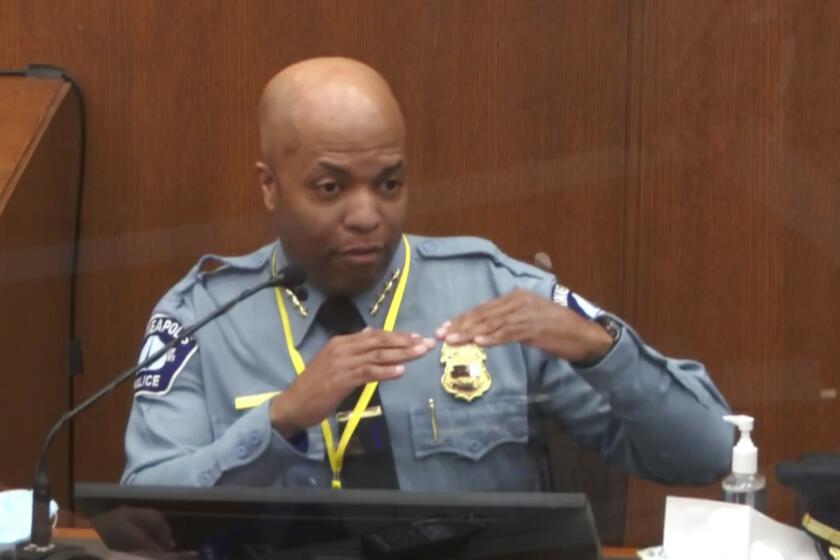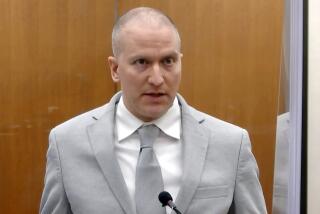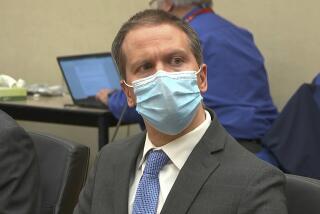Medical experts at Derek Chauvin trial say George Floyd died of lack of oxygen, not from drugs

- Share via
MINNEAPOLIS — George Floyd died of a lack of oxygen from being pinned to the pavement with a knee on his neck, medical experts testified at former Officer Derek Chauvin’s murder trial Thursday, emphatically rejecting the defense theory that Floyd’s drug use and underlying health problems killed him.
“A healthy person subjected to what Mr. Floyd was subjected to would have died as a result,” said prosecution witness Dr. Martin Tobin, a lung and critical care specialist at the Edward Hines Jr. VA Hospital and the medical school of Loyola University Chicago.
Using easy-to-understand language to explain medical concepts and loosening his necktie to illustrate a point, Tobin told the jury that Floyd’s breathing was severely constricted while Chauvin and two other Minneapolis police officers held the 46-year-old Black man down on his stomach in May with his hands cuffed behind him and his face jammed against the pavement.
The lack of oxygen resulted in brain damage and caused Floyd’s heart to stop, Tobin said.
Analyzing images of the three officers restraining Floyd for what prosecutors say was almost 9 ½ minutes, the doctor testified that Chauvin’s knee was “virtually on the neck” more than 90% of the time.
Tobin said several other factors also made it difficult for Floyd to breathe: officers lifting up on his handcuffs, the hard pavement, his prone position, his turned head and a knee on his back.
Chauvin kept his knee on Floyd’s neck for 3 minutes and 2 seconds after Floyd took his last breath, Tobin said. After that last breath, Floyd had “reached the point where there was not one ounce of oxygen left in the body,” the doctor said.
The Minneapolis police chief was less emotional than many other witnesses in the George Floyd trial. But his point was the same: Derek Chauvin used excessive force.
As prosecutors repeatedly played a video clip of Floyd on the ground, Tobin pinpointed what he said was a change in the man’s face that told him Floyd was dead. That moment happened around five minutes after police began holding Floyd down.
“At the beginning you can see he’s conscious, you can see slight flickering, and then it disappears,” Tobin said. “That’s the moment the life goes out of his body.”
Chauvin, 45, is charged with murder and manslaughter in Floyd’s May 25 death. Floyd was arrested outside a neighborhood market on suspicion of trying to pass a counterfeit $20 bill.
Bystander video of Floyd crying that he couldn’t breathe as onlookers yelled at Chauvin to get off him sparked protests and scattered violence around the U.S. last year.
Tobin also said the fact that Floyd was talking and can be seen moving on video does not indicate that he was breathing adequately. He said that a leg movement seen in the video was an involuntary movement resulting from a fatal brain injury, and that a person can continue to speak until the airway narrows to 15%, after which they “are in deep trouble.”
Officers can be heard on video telling Floyd that if he can talk, he can breathe.
During cross-examination, Chauvin’s attorney Eric Nelson pressed Tobin on that common misconception, pointing to earlier testimony that said Minneapolis officers are trained that people who can speak are able to breathe.
Nelson has argued that Chauvin did what he was trained to do and that Floyd’s death was caused by illegal drugs and underlying medical problems that included high blood pressure and heart disease. An autopsy found fentanyl and methamphetamine in his system.
Tobin said he analyzed Floyd’s respiration as seen on body-camera video, and explained that fentanyl typically cuts the rate of respiration by 40%, but that Floyd’s breathing was “right around normal” just before he lost consciousness.
Tobin also said the high level of carbon dioxide measured in Floyd’s blood in the hospital emergency room can be explained by the fact that he had stopped breathing under restraint nearly 10 minutes before paramedics began artificial respiration, as opposed to having his breathing suppressed by fentanyl.
Another prosecution witness, Dr. Bill Smock, an expert on deaths from asphyxia, backed up Tobin’s assessment. Smock said Floyd did not have symptoms of a fentanyl overdose such as constricted pupils and decreased breathing. He said Floyd’s actions were the opposite, because he was pleading for air.
“That is not a fentanyl overdose. That is somebody begging to breathe,” said Smock, the police surgeon in Louisville, Ky., and a former emergency room doctor. He said Floyd died of “positional asphyxia,” a lack of oxygen because of the position of the body.
On cross-examination, Nelson questioned Smock about Floyd’s history of heart disease, and got Smock to agree that a struggle with police could put stress on the heart and that shortness of breath could be a sign of a heart attack.
But when questioned again by the prosecution, Smock said there was no evidence that Floyd had a heart attack or sudden death from arrhythmia. The doctor said Floyd’s death was caused by a gradual decrease of oxygen over several minutes “because of the pressure being applied to his back and neck.”
Also Thursday, a forensic toxicologist testified that he had tested blood drawn from Floyd at the hospital, as well as urine from his autopsy, and had found a “very low” amount of methamphetamine. Daniel Isenschmid said fentanyl and a byproduct of its breakdown also were in Floyd’s system.
Isenschmid put the level of fentanyl in Floyd’s blood at 11 nanograms per milliliter. For perspective, he said that testing of more than 2,000 people arrested for driving under the influence of fentanyl revealed an average concentration of 9.59 nanograms per milliliter, and that dozens of them had levels higher than Floyd’s and survived.
On cross-examination, Nelson suggested there was no way to know how much fentanyl Floyd had ingested, and Isenschmid agreed. The defense attorney also said it’s impossible to know the concentration of fentanyl in street drugs.
“Every single pill you take, it becomes a unique experience for the person, right?” Nelson asked.
Isenschmid agreed.
Tobin, in his turn on the stand, used simple language, explaining that when the airway narrows, breathing becomes far more difficult, like “breathing through a drinking straw.”
At one point, the doctor loosened his tie and placed his hands on his neck and the back of his head to demonstrate how the airway works, inviting the jurors to examine their own necks. Most did so, though the judge later told them they didn’t have to.
The doctor calculated that at times when Chauvin was in a near-vertical position, with his toes off the ground, half of the weight of his body and gear — or 91.5 pounds — was directly on Floyd’s neck.
He said it appeared that Floyd was getting enough oxygen to keep his brain alive for about the first five minutes because he was still speaking. Tobin said the placement of Chauvin’s knee after the five-minute mark was less important, because Floyd would have already suffered brain damage.
Chauvin’s attorney has repeatedly shown the jury still images from video that he said showed Chauvin’s knee was on Floyd’s shoulder blade, not his neck. But nearly all of those images were captured after the five-minute mark, according to the time stamps.
More to Read
Sign up for Essential California
The most important California stories and recommendations in your inbox every morning.
You may occasionally receive promotional content from the Los Angeles Times.











